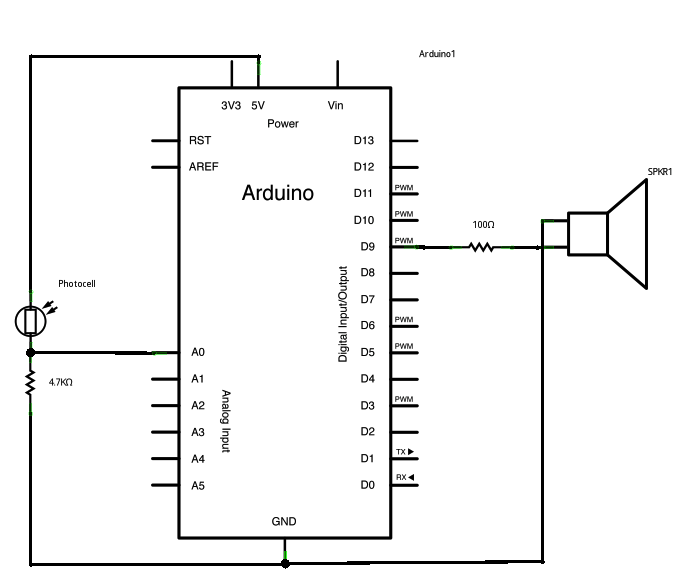
Hence in order to make the Piezo buzzer to make some noise we have to make the Piezo electric crystal to vibrate, the pitch and tone of noise depends on how fast the crystal vibrates. Here we apply a variable current (frequency) for which the crystal vibrates thus producing sound. We might have learnt about Piezo crystals in our school, it is nothing but a crystal which converts mechanical vibrations into electricity or vice versa. Understanding the Tone() function of Arduino:īefore we can understand how a tone () works we should know how a Piezo buzzer works. Piezo Speaker/Buzzer or any other 8ohm speaker.Arduino (any version – UNO is used here).
#Arduino tone example how to#
You will also learn how to play any piece of piano music with Arduino. At the end of this tutorial you will be able to play some famous tones of Pirates of Caribbean, Crazy Frog, Super Mario and Titanic. In this tutorial we will learn how simple and easy it is to Play Melody on Piezo Buzzer or Speaker using the Arduino tone () function. What if I told you that almost any theme songs that could be played on a piano can be mimicked on your Arduino with the help of a simple program and a cheap Piezo speaker? Some of your projects might need some sounds action to notify about something or just to impress the viewers. There are lots of Arduino Projects out here for you to try and have fun. Hall.Arduino is an excellent way to simplify and speed up your microcontroller projects, thanks to its community of developers who have made almost everything look simple.
#Arduino tone example generator#
^ A Tone Generator for Trinket by Bruce E.^ Note that this technique can't be used with the ATmega328 used on the Arduino Uno because the prescaler cannot be set to any power of 2.^ Tiny AVR Programmer Hookup Guide on SparkFun.TCCR1 = 0x90 | (11-octave) // for 8MHz clockįor an improved version of this routine, that can be used to play notes on the ATtiny85 pins 1 or 4, see Playing Notes on the ATtiny85. TCCR1 = 0x90 | (8-octave) // for 1MHz clock Void TinyTone(unsigned char divisor, unsigned char octave, unsigned long duration) Here's the complete program: /* TinyTone for ATtiny85 */ However, I decided it was simpler to use the delay() function to time the note after the delay has elapsed we stop the counter by writing 0 to the prescaler register. One approach is to get the timer to call an interrupt service routine on every cycle we can then count how many cycles have elapsed, and stop the counter after the appropriate number. To create a note of a specified length we need to stop the counter when the duration has elapsed. Once you program Timer/Counter1 with a divisor and prescaler it continues to generate a tone on output 1 indefinitely, irrespective of what the program is doing. Note that for historical reasons each octave goes from C to B for example, the next note after B4 is C5, and so on. To use it with an 8MHz clock add 3 to the prescaler, to reduce the frequency by an additional factor of 8, as shown in the commented second line of the routine. We will define a constant for each divisor to save having to remember them for example C is: const int Note_C = 239 The solution is to set the prescaler to divide the clock by 2^4, or 16. However, the divider for the counter must fit into 8 bits, so the maximum number we can represent is 255. To calculate the divisor for a given note frequency we first work out:įor example, C4 (middle C) is 261.63Hz, so we get: We then just need a table of divisors for the notes within one octave.

So TinyTone() is written to take three parameters the note divisor, the octave number, and the duration in milliseconds : TinyTone(divisor, octave, duration) The square wave is output on digital output 1.īecause the prescaler divides the clock by a power of two it provides a convenient way of generating the octave. This divides the clock frequency, which is either 1MHz or 8MHz, by a prescaler, and then by a one-byte counter. The first of these is already used by the delay() function, so I've used Timer/Counter1. The ATtiny85 contains two timers, referred to as Timer/Counter0 and Timer/Counter1. To test this application I used SparkFun's Tiny AVR Programmer (available in the UK from Proto-PIC ), which lets you program the ATtiny45 or ATtiny85 using the Arduino development environment. This post describes my simple TinyTone() function which takes advantage of the ATtiny85's prescaler to provide a compact tone routine that only needs a table of 12 divisors. There are several existing tone libraries for the ATtiny85, but they all seemed overcomplicated for what I wanted. I therefore needed to find a replacement way of generating simple tones. For a recent project based on the ATtiny85 I wanted to play some simple tones through a piezoelectric speaker, but unfortunately the Arduino tone() function isn't supported on the ATtiny85 because it doesn't have the appropriate timers.


 0 kommentar(er)
0 kommentar(er)
